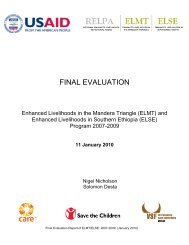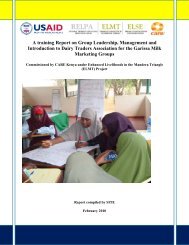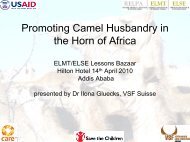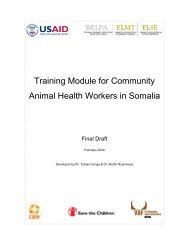care international in ethiopia – pastoral drop out study - ELMT Home
care international in ethiopia – pastoral drop out study - ELMT Home
care international in ethiopia – pastoral drop out study - ELMT Home
Create successful ePaper yourself
Turn your PDF publications into a flip-book with our unique Google optimized e-Paper software.
CONCEPTUAL MODEL FOR THE STUDY<br />
A <strong>study</strong> <strong>in</strong> <strong>pastoral</strong> <strong>drop</strong><strong>out</strong>s is a livelihood <strong>study</strong>. It is a movement of people from <strong>pastoral</strong><br />
type of livelihood to another one, which <strong>in</strong> most cases fated to be an <strong>in</strong>ferior <strong>in</strong> terms of<br />
<strong>in</strong>come generation and social status. These people often engage <strong>in</strong> a new non-<strong>pastoral</strong><br />
livelihood strategies as a result of their <strong>in</strong>ability to survive as <strong>pastoral</strong>ist due to loss of their<br />
livestock asset. The livelihood movement can encompass physical relocation of the person <strong>in</strong><br />
which case the <strong>in</strong>dividual migrates to a place where he can make a liv<strong>in</strong>g <strong>out</strong> of assets he<br />
owns or bound to have access and use right. However, <strong>pastoral</strong> <strong>drop</strong><strong>out</strong>s who are no longer<br />
able to make a liv<strong>in</strong>g from <strong>pastoral</strong>ism and have not managed to f<strong>in</strong>d an alternative<br />
livelihood could rema<strong>in</strong> with<strong>in</strong> the <strong>pastoral</strong> area. In either case such movement <strong>in</strong> livelihood<br />
strategies is a sign of downward economic and social mobility.<br />
It is essential to make a quick review of the concepts of susta<strong>in</strong>able livelihood and migration<br />
<strong>in</strong> order to clearly understand what a <strong>pastoral</strong> <strong>drop</strong> <strong>out</strong> is; the causes that drive <strong>pastoral</strong>ist<br />
<strong>out</strong> of the <strong>pastoral</strong> livelihood system; locations and social groups where they often go and<br />
how they adapt to a new environment. The follow<strong>in</strong>g sections briefly consider some basic<br />
ideas from the susta<strong>in</strong>able livelihood and migration literature to conceptually draw some<br />
lessons for the later empirical assessments and conclusions made <strong>in</strong> the report.<br />
Susta<strong>in</strong>able Livelihood<br />
Livelihood is def<strong>in</strong>ed as the assets, activities, and the access that jo<strong>in</strong>tly determ<strong>in</strong>e a<br />
livelihood strategy of an <strong>in</strong>dividual or household. Ability of <strong>in</strong>dividuals or households to<br />
pursue particular livelihood strategies is dependent upon the assets which they own and can<br />
access and use (Scoones 1998). Broadly def<strong>in</strong>ed, assets refer to ‘…capital which can be<br />
stored, accumulated, exchanged or depleted and put to work to generate a flow of <strong>in</strong>come or<br />
other benefits’ (Rakodi 1999). Five types of assets are commonly <strong>in</strong>corporated <strong>in</strong> livelihoods<br />
analysis namely physical/natural, human, social, f<strong>in</strong>ancial and personal assets.<br />
8












